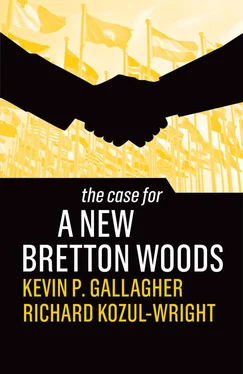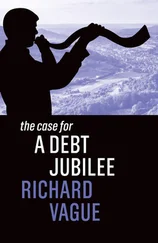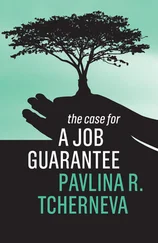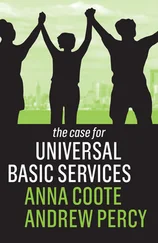The Takeaways from Bretton Woods 1.0
Efforts to reconcile the requirements of national governments with their international entanglements have a long history (Mazower 2013). What made Bretton Woods distinct from previous multilateral initiatives was a recognition that combining national economic goals with international peace and stability would require dedicated public institutions to ensure “the fullest and most effective use of the world’s resources.” The architects of these new institutions had to contend with three abiding and closely related challenges of global governance. First, how many resources and policy responsibilities could they procure from sovereign states to manage a supportive international environment (the sovereignty challenge)? Second, how would international policy priorities be set and responsibilities established across a diverse membership (the leadership challenge)? Third, how, if at all, would those who benefited the most from international cooperation compensate those who benefited the least (the distribution challenge)?
As will be further elaborated in the following chapters, there are four main takeaways from Bretton Woods that, we believe, remain relevant when thinking about governance in relation to contemporary global challenges:
1 Face up to failure. Austerity does not work; the gold standard and the outsized influence of financial interests had triggered widespread depression, insecurity, and conflict. A new order would require an ideological break with laissezfaire and adjustment through austerity.
2 Treat markets as means not ends. Economic security, personal safety, social justice, energy choices, and political representation should not be left to the dictates of markets. Prices and property rights can help to achieve more inclusive growth and development but require complementary institutions, effective regulation, and shared values that the market doesn’t itself provide.
3 Forge a set of shared national goals and common global interests. The international order was constructed to support the national goals of full employment and social welfare by providing five key global public goods: a stable monetary and exchange rate system; a global lender of last resort to provide liquidity to distressed nations; counter-cyclical and long-term lending; open markets’ including under recession; and a coordinated international economic policy.
4 Nurture cooperation. Rather than ad hoc summitry and bilateral policy negotiations, a set of permanent institutions is needed to monitor, coordinate, and guide the interdependent economic system into the future.
These ideas underpinned the creation of the International Monetary Fund (IMF), the International Bank for Reconstruction and Development (IBRD), the General Agreement on Tariffs and Trade (GATT), and their subsequent extensions and offspring. While far from perfect, this was a powerful attempt to globalize economic relations while maintaining sufficient policy autonomy for nation states to pursue a broad set of economic and social goals.
In this book we make the case that a spirit similar to that of Bretton Woods needs to be evoked if the twenty-first-century global economy is to become more stable, more equitable, and environmentally sustainable. At the same time, the practice of multilateralism must change profoundly to meet these objectives, and with respect not only to its recent neoliberal deviation, but also to the original post-war multilateral model which relied unduly on American hegemony and was never able to properly accommodate development goals.
From Managing Capitalism to Enabling Capital
Financial interests were noticeable by their absence from the Bretton Woods conference. That was no accident. Disciplining the behavior of finance capital was seen, by the architects of the conference, as key to the stability of the post-war system. But those interests resented the constraints on their activities and were quick to push back and sow seeds of discontent in the years immediately following the conference. New coalitions were established to finance political parties, candidates, and an apparatus of experts that pushed for a revival of classical liberalism, first in national capitals and then at the international institutions themselves (Blyth 2002; Gallagher 2015). The overarching philosophy is now referred to as “neoliberalism,” which pushes for unregulated markets and individual freedoms as primary ends, arguing that “free trade,” “free enterprise,” and the unbridled movement of capital are the only guarantees of a healthy economy and widespread prosperity.
These efforts achieved some early success, but not enough to reverse the ideological tide in support of social solidarity and interventionism that had emerged from the wartime experience and continued to animate policy discussions over the following three decades. They began to yield more bountiful returns from the early 1980s with the abandonment in advanced countries of full employment, the privatization of state-owned assets, and the deregulation of financial markets, with further gains as these measures were adopted and spread by the Bretton Woods institutions.
The resulting “liberal international order,” often lauded as “rules-based,” now serves gargantuan and increasingly footloose firms in their endless pursuit of higher rents in heavily concentrated markets across the globe. The result is a polarized world economy in which instability and insecurity have become the norm for more and more households in rich and poor countries alike.
There are three pictures of what the neoliberal economic order now looks like that we think will help illuminate the scale of the problem and the urgent action that is needed. The first is what has become known as the “Elephant Curve,” designed by the former World Bank economist Branko Milanovic. Figure 1.1 reproduces that figure, showing how the top 1 percent of the global income spectrum has captured 27 percent of total growth since 1980, while the bottom 50 percent captured just 12 percent over the same period – and the fact that the latter amount was gained by developing countries is largely explained by the rise of China and India. The middle classes in the United States and Europe, and the vast majority of the world’s poor, have felt their incomes squeezed.
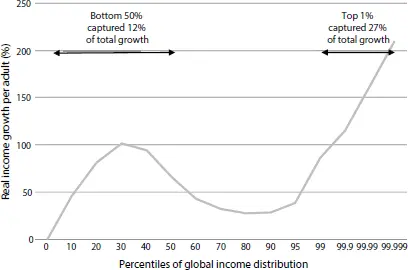
Figure 1.1The Elephant Curve: Global Income Distribution and Real Income Growth, 1980–2016
Source : World Inequality Report 2020
The second picture is a figure we created for an earlier report and dubbed “The Crocodile Graph.” Shaped like the jagged mouth of that rapacious reptile, this figure exhibits the top 2,000 multinational corporations’ profit in terms of percentage point change of GDP, versus the global labor share of income.
The World Inequality Lab estimates that since 1980 inequality has risen or remained extremely high nearly everywhere in the global economy, with some of the sharpest rates of increase occurring in India and China and among emerging-market and developing countries, showing that even in the places where larger aggregate growth has occurred it is not shared across the population (World Inequality 2020).
The third picture is the Weather, Climate, and Catastrophe Index. The twenty-first century has been marked by climate-related natural catastrophes that have posed great economic risks to the world economy, and the risks are rising each year. There has been an increased incidence of floods, droughts, heatwaves, and fires globally that has cost hundreds of billions of dollars on an annual basis. The price tag for these events has been upwards of $6 trillion in this century. Just one event in Dominica in 2017 caused over 200 percent of GDP in economic damage, while the cost for just the first half of 2021 was $298 billion, showing that the climate crisis is bringing major economic costs as we speak.
Читать дальше
